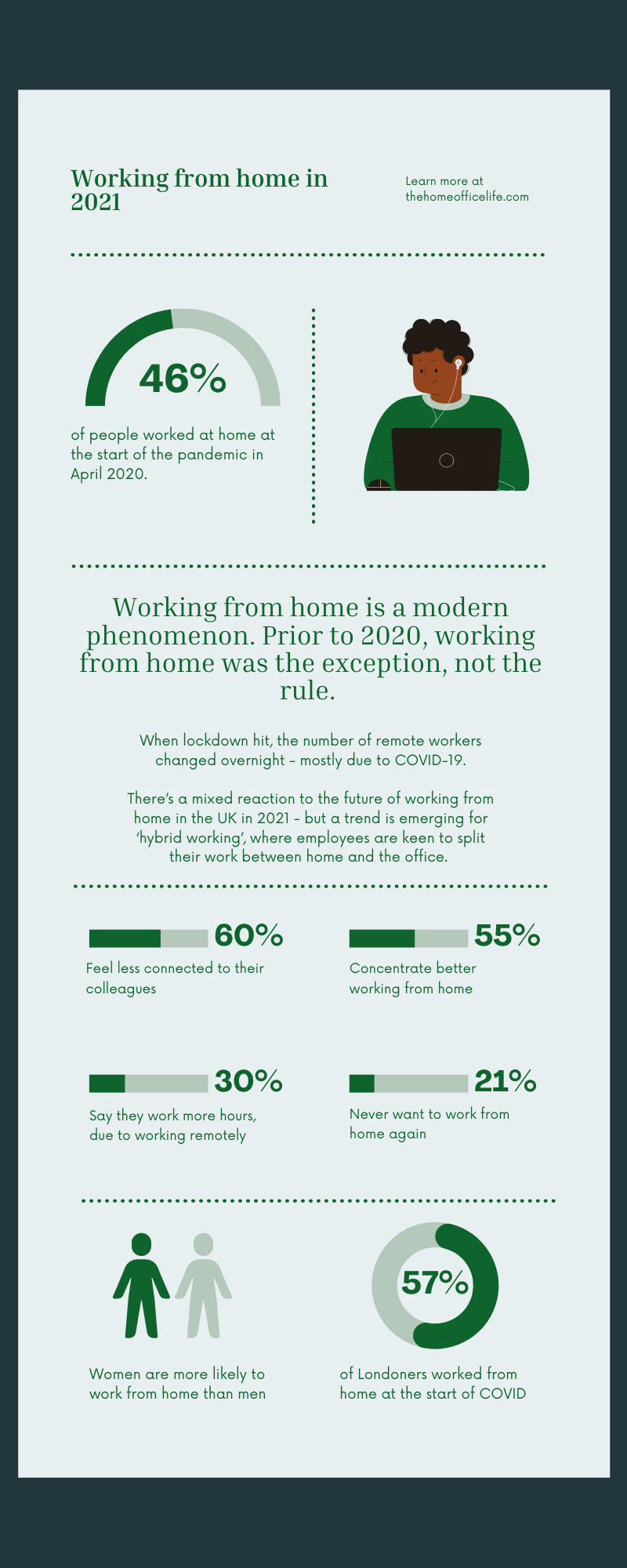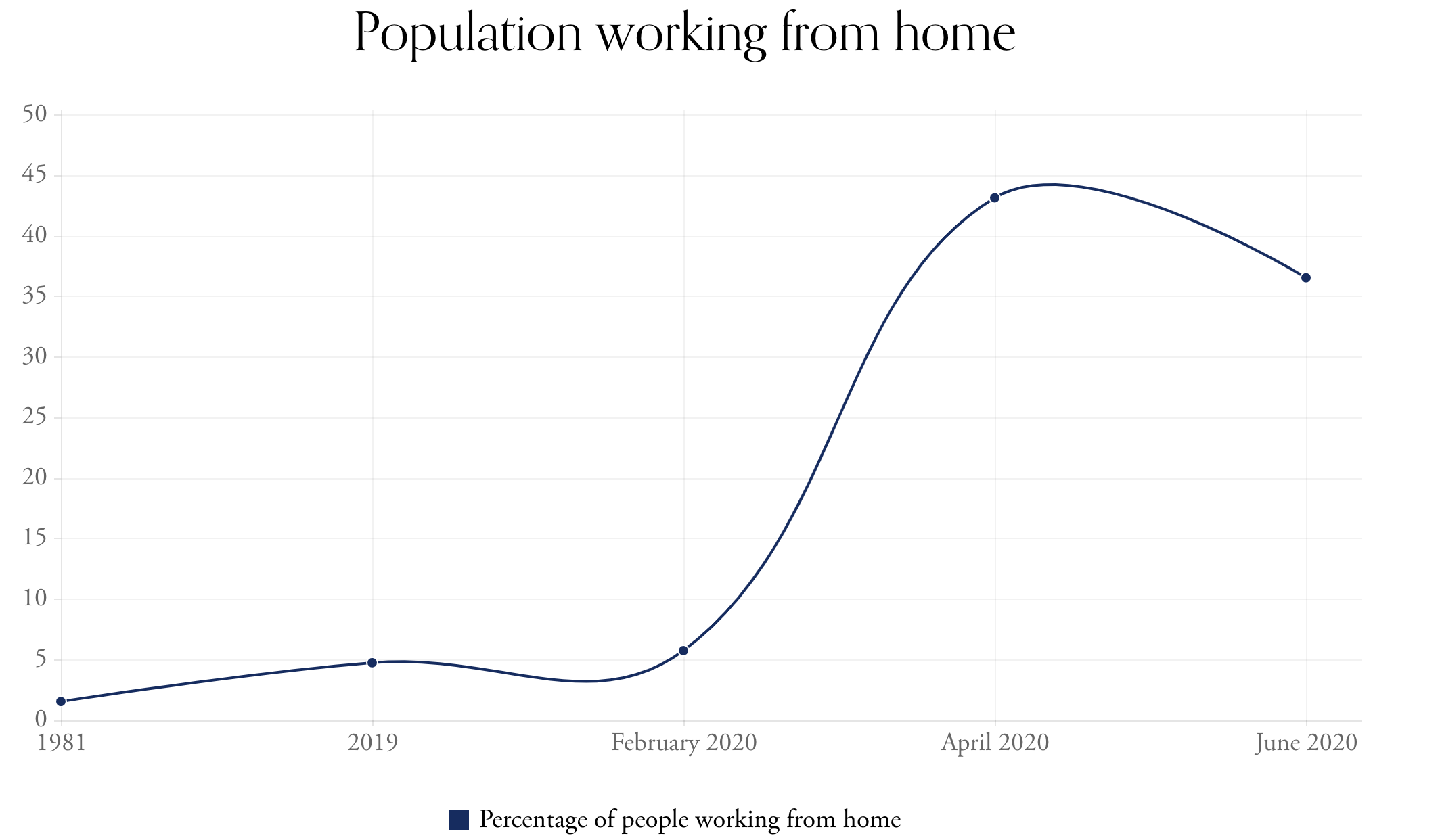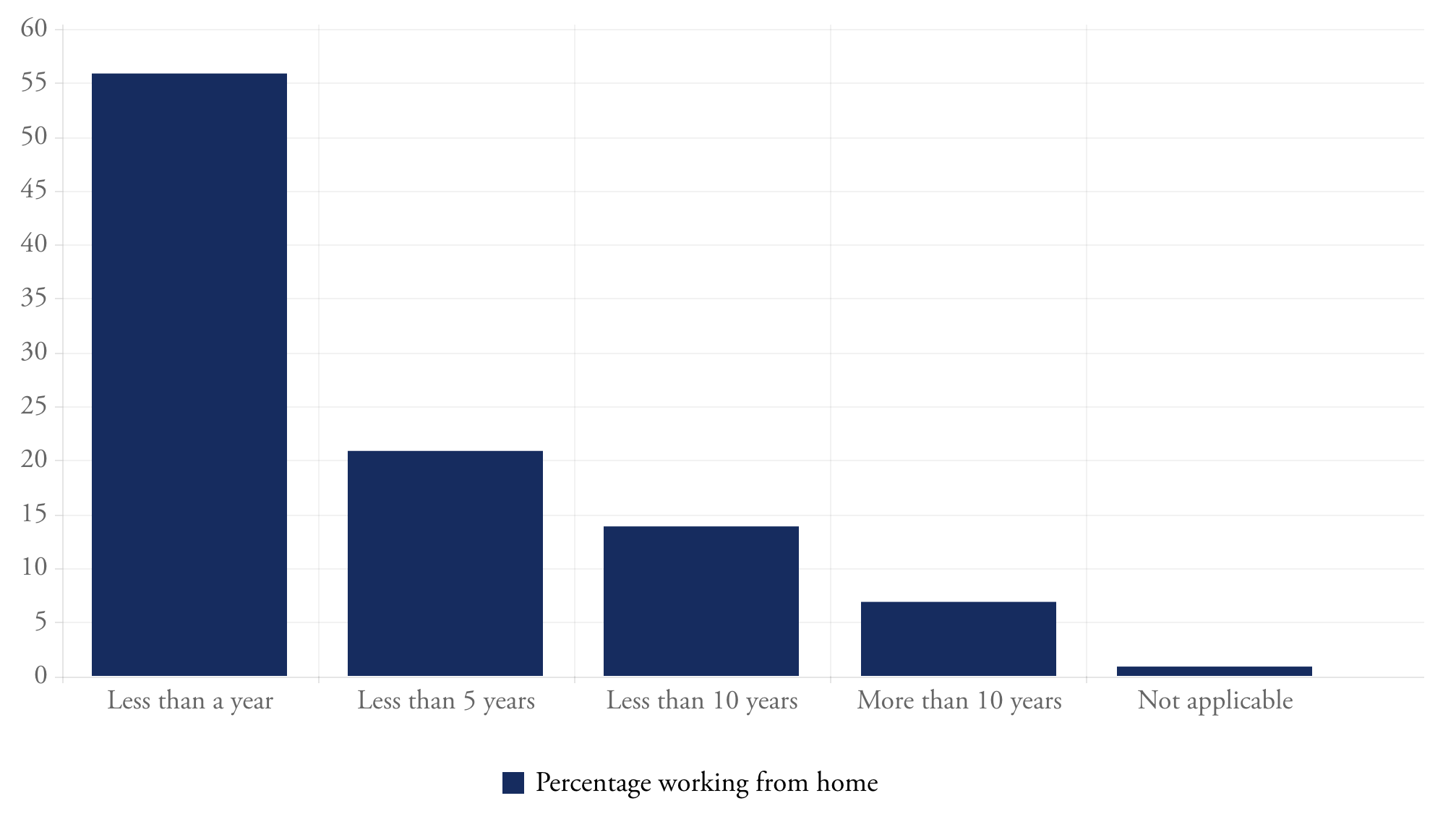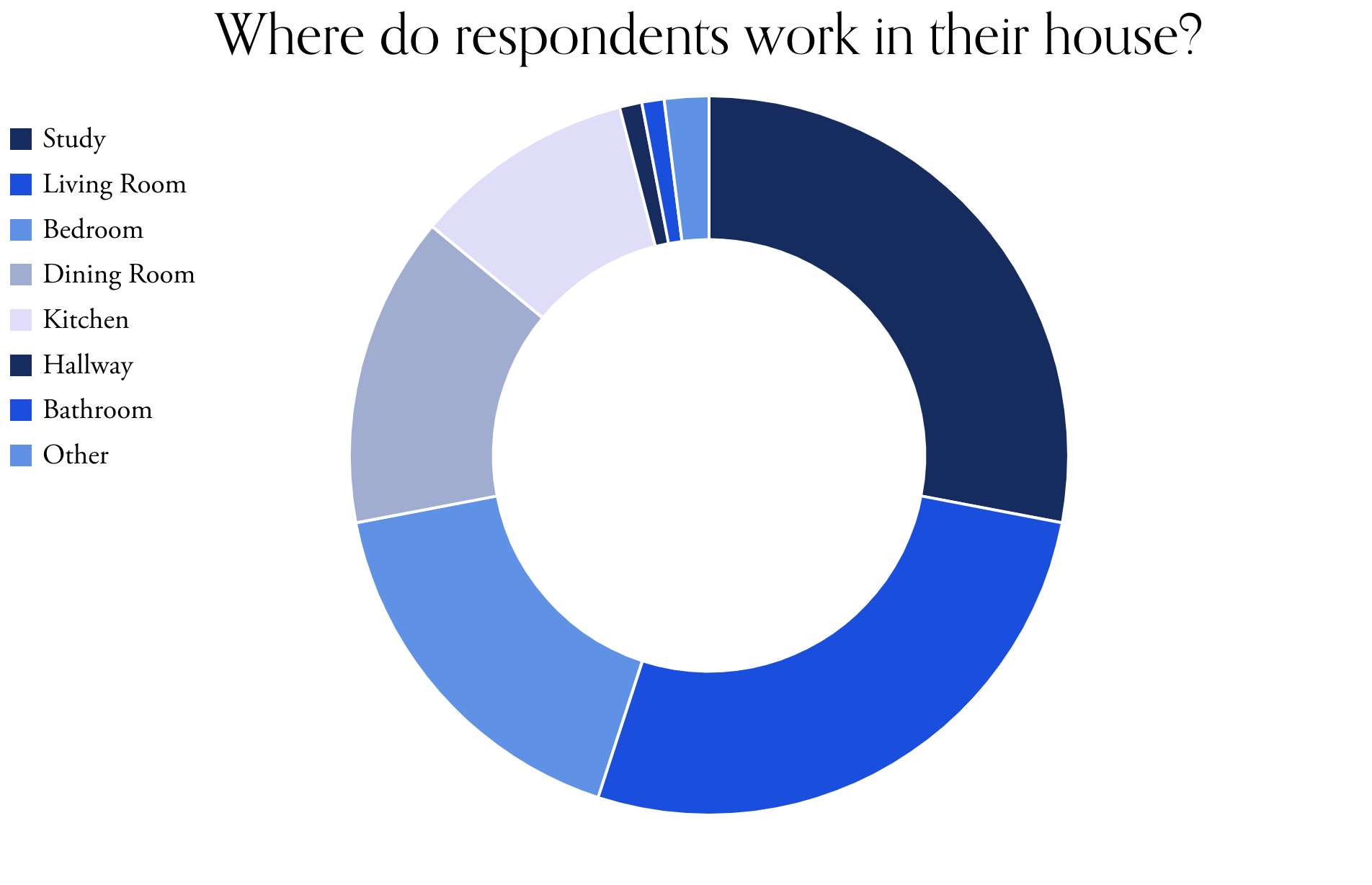Working from home UK statistics 2024
Updated: 27 February 2024
Since the start of the COVID-19 pandemic in March 2020, the numbers of people working from home in the UK has dramatically increased. That’s no surprise.
But now, with advice from the government constantly changing, how will homeworking in the UK change? Will the numbers of remote workers decrease as we leave 2023 and into 2024? Will we embrace hybrid working? What will the trends look like?
Here, we have collated the information available for working from home in the UK in 2020, 2021, 2022, 2023 and 2024 from a series of studies and surveys to provide a picture on what the WFH landscape looks like.
Recent working from home research (2024)
52% of business leaders surveyed believe that hybrid working is the most supportive environment for employee productivity (source)
47% of female office workers and 44% of male office workers believe hybrid working is better for their mental health (source)
53% of business leaders believe hybrid working helps employees better manage the costs associated with work (source)
82% of men and women believe their employer now has a greater responsibility to offer health and wellbeing support post-pandemic (source)
Remote working prior to 2020
Working from home is a modern phenomenon. Prior to 2020, working from home was the exception, not the rule.
Homeworking was relatively rare in 1981 when only 1.5% of those in employment reported working mainly at home, but by 2019 it had tripled to 4.7% (source)
The proportion reporting that they worked exclusively at home rose from 5.7% of workers in January/February 2020 to 43.1% in April 2020 (source)
Before the pandemic, staff went into the office an average of 3.8 days a week. (source)
Population working from home
Working from home at start of lockdown
When lockdown hit in March 2020, the numbers of remote workers changed overnight - mostly due to the impact of COVID-19.
In April 2020, 46.6% of people in employment did some work at home (source)
Of those who did some work from home, 86.0% did so as a result of the COVID-19 pandemic (source)
Women were slightly more likely to do some work at home than men, 47.5% and 45.7% respectively (source)
57.2% of people living in London did some work at home (source)
40% of respondents’ perceptions about working from home has substantially improved (source)
5% of those respondents’ perceptions have slightly worsened (source)
Working from home after lockdown
There’s a mixed reaction to the future of working from home in the UK - but a trend is emerging for ‘hybrid working’, where employees are keen to split their work between home and the office.
Fifty of the biggest UK employers have said they have no plans to return all staff to the office full-time in the near future (source)
21% of respondents never want to work from home in 2022 (source)
19% of respondents want to work from home 5 days a week in 2022 (source)
Over 55s are the most likely to want to work from home permanently (source)
16-24 year olds favour working in the office full-time (source)
85% of employees currently working from home want a ‘hybrid’ approach of both home and office working in future (source)
In June 2021, 44% of those aged between 30 and 49 worked from home because of COVID-19 (source)
38% of workers earning £40,000 or more, and 32% of those earning between £30,000 and £40,000, hybrid worked between 27 April and 8 May 2022 (source), as lower income earners are less likely to work from home
78% of those who worked from home in some capacity said that being able to work from home gave them an improved work life balance (source)
47% workers recorded improved well-being from working from home in some capacity (source)
The working from home tax relief was claimed by more than 3 million people for the 2020/21 tax year (source)
As of May 2023, 39% of workers in Great Britain had worked from home at some point in the previous 7 days, with 73% of British workers saying they had travelled to work in the last week (source)
Hybrid working - the future of working from home?
With lockdown measures now eased in many countries, employers and employees are now trying to strike a balance between pre-pandemic working in the office and a more flexible working from home culture, which has led to a recent rise in “hybrid working”, where employees spend their work time split between the office and home. What impact has this had? Can it be maintained long term? Is hybrid working productive? It certainly appears that more and more people are returning to the office in some capacity. If you are currently looking for remote job options, you can consider opportunities offered by big companies. For instance, you can browse Amazon work-from-home jobs that unite a variety of fields.
80% of people leaders reported that a hybrid setup was exhausting for employees (source)
47% of American workers prefer to work in a hybrid model (source)
In the UK, this is even higher, with 58% of workers preferring to work in a hybrid model (updated source)
21% of respondents who had quit their jobs in 2021 reported doing so because of lack of flexible working hours or location (source)
Office workers went to the office an average of 3.8 days per week pre-pandemic. Post-COVID, this has reduced to an average of 1.4 days per week (source)
Just 13% of workers go into the office on a Friday (source)
The proportion of people hybrid working as risen in 2022. 14% worked from home exclusively between 27 April and 8 May 2022, while 24% both worked from home and travelled to work (source)
High earners are more likely to hybrid work. 38% of workers earning £40,000 or more hybrid worked between 27 April and 8 May 2022, while only 8% of those earning up to £15,000 reported hybrid working (source)
Commuting to work
Since September 2022, there has been a surge in workers returning to their offices in Central London (source)
As of October 2022, representative average daily demand on the London Underground was about 82% of pre-pandemic levels (source)
As of October 2022, bus demand was around 84% of pre-pandemic levels (source)
Cycling now exceeds pre-pandemic levels of demand at 140% of pre-pandemic levels (source)
Differences among the days of the traditional working week have been exacerbated since the pandemic, with Tuesday to Thursday now having a relatively higher difference to Mondays and Fridays (source)
Hiring and working from home
Research suggests that companies with flexible remote work policies are find it easier hiring and adding headcount compared to those with full-time in-office policies. The data was collected from a combination of Scoop's quarterly Flex Index, which catalogs flexible work policies of around 4,500 companies, and data from PeopleDataLabs about individual companies' headcount growth.
Companies with fully flexible remote work policies (allowing full-time remote work or choice about office attendance) grew headcount by 1.9% on average in Q2 2023
Companies with structured hybrid policies (workers come into the office between one and four days a week) grew headcount by 1.5% over the same period
Companies with full-time in-office policies grew headcount by just 0.8% in Q2 2023
Between July 2022 and July 2023, fully flexible companies grew headcount by 5.6%, hybrid companies by 4.1%, and full-time in-office companies by 2.6%
The trend of fully flexible and hybrid companies outperforming full-time in-office companies remained consistent across different company sizes
Even after removing tech firms from the analysis, companies with flexible or hybrid setups still grew headcount at least 0.5% faster than full-time in-office firms, across various company sizes (source)
How long have people been working from home?
Some people are seasoned professionals when it comes to working from home, others have only started to embrace homeworking in the past few years. As we can see from a 2020 survey, however, most remote workers around the world had only done so since the start of COVID-19:
56% of respondents have worked remotely for less than a year
21% have worked remotely for less than 5 years
14% have worked remotely for less than 10 years
7% have worked remotely for over 10 years
1% could not respond (source)
Productivity of remote workers
It’s not clear how much working from home improves the productivity of workers, but those who’ve found remote working beneficial for their productivity levels want to remain working from home in the future. In fact, many have found that they’ve actually worked longer hours because they’re at home.
40.9% of homeworkers reported that they were able to get as much work done in June 2020 as they were six months earlier (source)
28.9% said that they got more done, while 30.2% said that their productivity had fallen (source)
65.5% of employees who reported that they were able to produce much more per hour while working at home in lockdown wanted to work mainly at home in the future (source)
30% report an increase in their hours whilst working from home (source)
55% report that they concentrate better working from home (source)
80% would recommend working at home to a friend (source)
80% are able to accomplish all their tasks remotely (source)
Economists at MIT and UCLA found that WFH resulted in 18% less productivity for data-entry workers in India compared to those who worked in an office (source)
A study of 61,000 Microsoft employees suggested WFH is bad for communication between different teams (source)
How much work can respondents do at home?
Working from home and mental health
Mental health in the workplace, and employee wellbeing in general is important, whether they’re in the office or at home. It’s been found that people are generally happier working from home because it allows for more flexibility, but there has been struggles when it comes to communicating and collaborating with teammates.
81% of younger workers say they would feel more isolated without time in the office (source)
56% reported an increase in happiness levels when working (source)
48% reported they need to communicate more to demonstrate their value (source)
60% reported that they feel less connected to colleagues (source)
30% have found it difficult separating their home lives from their work lives (source)
29% of organisations have introduced additional resources to support employees’ physical and mental wellbeing (source)
The biggest struggle with working remotely is not being able to unplug, followed by difficulties with collaboration and communication (source)
The most named benefit of working from home is flexible scheduling, followed by the lack of commute (source)
Working from home and attire
The increase in working from home seemingly brought in a whole new fashion trend - comfy working from home clothes. Many workers embraced - and continue to enjoy - the benefits of a more relaxed outfit when working from home. But some have argued against the typical WFH dress code. What do you think?
89% of employees said “absolutely not” to formal dress codes for remote work
65% of managers think employees who work from home should dress smarter
55% of managers think remote workers should dress more smartly on video calls
53% of employees say they dress differently for working in the office versus working at home
48% of employers said they were considering a formal dress code for hybrid work
42% of employees said having a formal dress code introduced would cause them to look for a new job (source)
WFH statistics by industry
As expected, the popularity and success of working from home differs depending on the type of work and type of business, with those working in IT finding it easiest to work from home.
Where homeworkers work
Lucky homeworkers already had an office to use when lockdown and subsequent work from home requests struck. However, many WFHers have had no option but to use another room for work.
Where do respondents work in their house?
Benefits of working from home
There are more people working from home than ever, whether or not by choice. There are a number of advantages to homeworking in the UK, according to those who do:
The main benefit is flexible scheduling, according to 50% of respondents
The second main benefit is a lack of commute, according to 43% of respondents
34% find that working from home allows them to look after family, pets, ageing or unwell relatives better
33% love the savings that WFH brings
Another benefit is reduced anxiety/stress, according to 32% of respondents
25% cited improved health, whether it’s mental, physical or spiritual
Reduced office politics is another big benefit to working from home, according to 19% of respondents
18% state that homeworking gives them the freedom to travel or relocate entirely (source)
Disadvantages of working from home
Despite the flexibility of working from home, there are times when remote workers struggle to manage their work-life balance. Here are some of the cons teleworkers around the world have when working remotely in 2021:
27% struggle to unplug at the end of the day
16% have difficulties with collaboration and communication
16% experience loneliness
15% have distractions at home
12% struggle to stay motivated
7% find it challenging working in different timezones to their teammates (source)
The rise of videoconferencing
Along with the sudden rise of working from home, the use of videoconferencing apps like Zoom, Microsoft Teams and Google Meet has dramatically increased in the last few years.
How many users downloaded Zoom at the start of the pandemic?
In February 2020, there were just under 5 million downloads of the Zoom app (on iOS and Android) globally. By March 2020, this had surged to 26.9 million downloads, according to Prioriti Data (source).
What were the leading videoconferencing platforms used in 2020?
Zoom - 50.3% of respondents
Microsoft Teams - 12% of respondents
Facebook Live - 9.4% of respondents
Instagram Live - 7.3% of respondents
GoToWebinar - 5.8% of respondents
YouTube Live - 5.2% of respondents
On24 - 4.7% of respondents
WebEx - 1% of respondents
At the onset of the pandemic, Zoom was by far the most used videoconferencing platform compared to similar counterparts, like Teams and WebEx (source). This has led to the rise of the so-called “Zoom fatigue”.
Parenting and working from home
Remote work trends driven by the pandemic:
In 2021, 58% of parents with kids under 18 were working remotely all or most of the time, up from 44% pre-pandemic (source)
75% of surveyed parents worked from home more frequently during the pandemic (source)
25% of remote working parents reduced work hours or left jobs due to childcare and schooling responsibilities (source)
61% of parents want to maintain primarily remote work even after the pandemic (source)
Benefits of parents working from home:
72% cite avoiding virus exposure as a motivator for remote work(source)
54% reported remote work allows more family time (source)
51% reported increased productivity working from home (source)
Challenges of parents working from home:
54% of parents who worked from home reported decreased productivity when working while caring for children at home (source)
40% of remote working parents struggle to stop working after hours (source)
Gender disparities in parents working from home:
Round up of working from home statistics
Scroll along the charts above.











